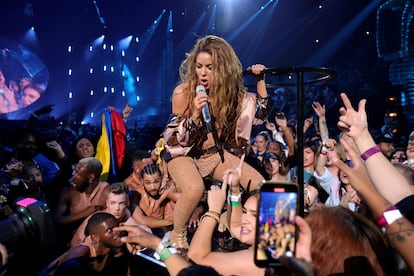Where Shakira is headed: Between lurches and evolution
By embracing the most fashionable musical styles, the Colombian singer has created a schism among her followers


Shakira has straightened out a musical career that was shaky, even in semi-retirement. And she’s done it in record time. However, there’s been controversy – and disappointment – surrounding how she’s achieved a reboot.
Ana Soriano, 42 — a devoted Shakira follower — feels that “Shakira has lost her essence. That pop-rock artist who wrote meaningful lyrics no longer exists,” she laments. On the other side of the debate, Sebas Álvarez, 37, and also a Shakira fan, opines that “she’s an artist who adapts very well to the times.”
These two currents are defended with equal ardor by specialists, such as Pablito Wilson. An Argentine, he’s one of the great experts in current Latin music and author of the reference book Reggaetón: Una revolución latina. Currently, Wilson lives in Colombia, Shakira’s homeland. From there, he speaks with EL PAÍS by phone. “I think Shakira’s achievement must be highly-valued,” he emphasizes. “I would dare to say that, right now, she’s the greatest artist in the world. Succeeding as she is — at more than 40-years-old — seems like an unprecedented case to me.”
“Her musical evolution also seems totally coherent to me. You listen to songs like Monotonía (2022) and you realize that Shakira has done a thorough study to understand social media today — to understand how millennials, centennials, speak. [She’s reached] a middle point between what she wants to do and what works commercially.”

Almost since the beginning of her career in the early-1990s, Shakira — who was born in the Colombian city of Barranquilla 46 years ago — has released long albums every three or four years. The period of greatest silence is actually right now, since her last full album, El Dorado, dates back to 2017. It’s been six years without a new album, and five years since her last tour, in 2018. Instead, what she’s placed on video-sharing platforms are individual songs — another reason for the schism among her fanbase.
It all started with Te felicito (2022), with Rauw Alejandro. But she reached her peak with the famous Session 53 in the company of Argentine DJ Bizarrap. She’s continued flying high with her duets with Karol G (TQG) and Manuel Turizo (Copa vacía). In her latest collaboration — El Jefe, released on September 20 — she took on the fashionable corrido tumbado genre of ballads, with the Mexican band Fuerza Regida.
All of her most-recent songs are united by an identical story (her separation from former soccer player Gerard Piqué) and an intention to embrace today’s fashionable rhythms: reggaeton, hip hop, corrido tumbado… a hodgepodge of genres that, for simplicity’s sake, is dubbed “urban music.”
Chucky García is a Colombian journalist and music promoter. He’s interviewed Shakira twice: once when she was starting out and once when she was already a star living in Miami. “Shakira’s musical essence needs to be [properly contextualized]. She was trained as an artist in Miami, under the advice and production of Emilio and Gloria Estefan. In other words, she’s always been mainstream. She was already in Miami when she was growing up. So, there’s not much essence of, say, a Tom Waits-type [grunge] artist.”
“Shakira has always been a trendsetter,” he continues. “And I think she’s confirmed this lately. If tomorrow, for example, something called flamenco corrido tumbado suddenly becomes fashionable [in the English-speaking world], she’s going to make a song about it.”
That being said, García sees an important change in her latest moves “Shakira’s albums that people like the most — such as Pies descalzos (1995) or ¿Dónde están los ladrones? (1998) — have an album concept, they’re quality Latin pop-rock. What she’s doing now, musically, is embracing the most popular trends. Now, that’s certainly criticizable. She’s an artist who’s had a good, mature career, but now she’s jumping from one place to another, looking for the trend of the moment. It’s not understandable, because we’re not talking about a singer who’s starting out and needs visibility: she already has all the visibility in the world.”

Shakira’s 30-year-long career can be divided and simplified into three stages: the 1990s and the early-2000s, where she polished a Latin pop-rock singer-songwriter style, with songs including Antología, Suerte (Whenever, Wherever) or Ciega, Sordomuda. Then, the second, when she began to experiment with dance genres and interact with other artists, from Alejandro Sanz to Rihanna, putting out songs such as Hips Don’t Lie, She Wolf, or the famous Waka Waka, the official theme song of the 2010 World Cup in South Africa. Her latest stage entails breakup themes and an embrace of urban music.
In all three stages of her career, Shakira has had songs at the top of the charts. And, as for live performances, the Colombian demonstrated from the beginning that she was a great stage power, praised in all forums. And, of course, we mustn’t forget her two moments of glory that were seen by millions of people on TV: the 2020 Super Bowl performance with Jennifer Lopez (considered the best musical interlude in the history of this event) and her 10-minute-long performance at the MTV Video Music Awards this past September.
It’s not the first time that Shakira deals with the topic of heartbreak in her songs. However, she’s now doing it in a more explicit way, touching on a specific person. Aïda Camprubí — a Barcelona-based music journalist specializing in new genres — tells EL PAÍS about the themes of the Colombian singer’s new songs: “She’s a woman empowering herself through spite. And that gets used against her. Women are judged a lot when we get tough, but when guys say harsh things in their lyrics, they’re not judged as much. These discourses are [normal when coming from] men, because they’re associated with toughness, masculinity, strength…”
“Women have always sung about breakups,” Camprubí notes, “but usually from a place of sorrow and abandonment. And now, they do it out of rage. And a woman singing out of rage [is very different]. It seems that [many male audiences] don’t like seeing angry women. I don’t know why we have to limit ourselves to expressing beautiful and vulnerable feelings — we can also sing about brutal feelings. It’s very uplifting.”

Regarding Shakira’s collaborations with Bizarrap, Karol G, or her immersion in Mexican ballads, Camprubí points out that it’s “super normal for her to pay attention to current genres. Shakira has always tried very different things. It’s a natural phase for a restless artist like her. These aren’t lurches: she’s an evolving artist. Some may like it and some may not, but an artist deserves to go through [as many] phases as she wants.”
Pablito Wilson goes further: “Shakira has impact, legacy, and validity. She has a variety of values that I don’t see in any of the pop artists of the moment. For example, Bad Bunny lacks a legacy. Taylor Swift has a lot of impact in the United States, but not so much in Latin America. Madonna has a legacy, but she’s already lost relevance.”
Shakira’s next steps inevitably involve completing an album and, above all, going on tour. No matter how many listens her new songs get, the bulk of the money in the music industry currently comes from live performances. In her only long interview since the new phase of her career began, in Billboard magazine, the singer promises her fans that both of these things will happen in 2024. “When the year started and I got that first No. 1, then the other, back-to-back, I thought, ‘This can’t be happening to me at 46 years old.’ It was so exciting to break the mold or reinvent the paradigms.”
In 1999, Gabriel García Márquez dedicated an extensive report to his compatriot. Shakira was 22-years-old at the time and had already released four full-length albums. The Nobel Prize winner wrote: “Shakira’s music has a personal imprint that’s unlike anyone else’s. No one sings or dances like her at any age, with an innocent sensuality that seems to have been invented by her.”
Today, there’s no debate about the Colombian singer in her country. “There’s unanimity: she’s a heroine,” affirms Colombian producer Chucky García. And he adds: “For 90% of people, she’s untouchable. Even when the Treasury thing happened [in Spain regarding unpaid taxes], the majority justified it. They said: ‘Well, the Spanish came 500 years ago and took the gold, so now it’s okay if she defrauded the Spanish Treasury!’”
In the end, as you just read, we end up deviating from the music.

Sign up for our weekly newsletter to get more English-language news coverage from EL PAÍS USA Edition









































